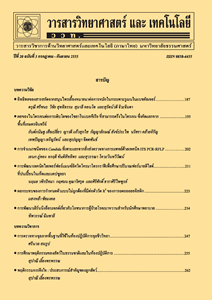การปรับปรุงสมรรถนะและวิเคราะห์การใช้พลังงานของกระบวนการอบแห้งแบบลมร้อนด้วยลมไอออนนิก
Main Article Content
บทคัดย่อ
บทคัดย่อ
หลักการของอีเล็กโตรไฮโดรไดนามิกส์ (EHD) ถูกนำมาประยุกต์ใช้สร้างลมไอออนนิกเพื่อเพิ่มอัตราการอบแห้งวัสดุพรุนในกระบวนการอบแห้งแบบใช้ลมร้อน บทความนี้ศึกษาผลของขนาดของแรงดันไฟฟ้าและความเร็วของลมร้อนที่มีต่อการถ่ายเทความร้อนและถ่ายเทความชื้นของวัสดุพรุน รวมถึงเปรียบเทียบค่าพลังงานจำเพาะ (SEC) ที่ใช้สำหรับการเพิ่มอัตราการอบแห้งระหว่างการใช้สนามไฟฟ้าและการเพิ่มความเร็วของลมร้อน ในการทดลองลมร้อนถูกควบคุมอุณหภูมิที่ 60 OC และที่ความเร็ว 0.35-1.4 m/s แรงดันไฟฟ้าทดสอบที่ค่า 0-30 kV จากการทดลองพบว่าอิทธิพลของสนามไฟฟ้าทำให้กระแสลมเกิดการหมุนวน ซึ่งส่งผลทำให้การไหลแบบแยกบริเวณผิวหน้าของวัสดุพรุนถูกทำลายลง เป็นผลให้อัตราการถ่ายเทความร้อนและความชื้นบริเวณผิวหน้าของวัสดุพรุนเพิ่มขึ้นอย่างมาก โดยขนาดความเร็วของลมแปรผันกับขนาดแรงดันไฟฟ้าที่เพิ่มขึ้น ด้วยการใช้สนามไฟฟ้าอัตราการอบแห้งเพิ่มขึ้นประมาณ 1.4-1.8 เท่า ของการอบแห้งด้วยลมร้อนทั่วไป จากการเปรียบเทียบการใช้พลังงานพบว่าค่า SEC ของการใช้ EHD ร่วมกับลมร้อนที่ความเร็วต่ำมีค่าต่ำกว่าของการเพิ่มความเร็วลมร้อนเพียงอย่างเดียวประมาณ 30-60 เปอร์เซ็นต์ นอกจากนี้การใช้ EHD จะมีประสิทธิผลมากในช่วงที่วัสดุพรุนมีความชื้นภายในสูง
คำสำคัญ : อีเล็กโตรไฮโดรไดนามิกส์ (EHD); กระบวนการอบแห้ง; การเพิ่มการถ่ายเทมวลและความร้อน; ค่าพลังงานจำเพาะ (SEC)
Abstract
Electrohydrodynamics is used to create ionic wind to enhance the drying rate of a porous material during hot air drying. This study experimentally investigates the effects of electrical voltage and hot-air velocity on heat transfer and moisture removal of a porous material. In addition, the study compares the specific energy consumption (SEC) needed to enhance the drying rate when utilizing electric fields and when increasing the hot-air flow velocity. Air temperature is controlled at a temperature of 60 OC and a velocity in the range of 0.35-1.4 m/s. The electrical voltage is tested in the range of 0-30 kV. It is found that the electric fields induce airflow to circulate above the material surface, causing the flow separation to be eliminated and resulting in higher rates of heat transfer and moisture removal. The airflow velocity is noted to be proportional to the voltage employed. With electric fields, the drying rate is improved by approximately 1.4-1.8 times. By comparing the energy consumption, it is found that SEC of the EHD-assisted drying process is lower than when enhancing the drying rate by increasing the airflow velocity. In addition, SEC of EHD-enhanced process is noted to be lower than that of the process without EHD by 30-60 %. Utilizing EHD is highly effective when the moisture content in a porous material is high.
Keywords: electrohydrodynamics (EHD); drying process; heat and mass transfer enhancement; specific energy consumption (SEC)


